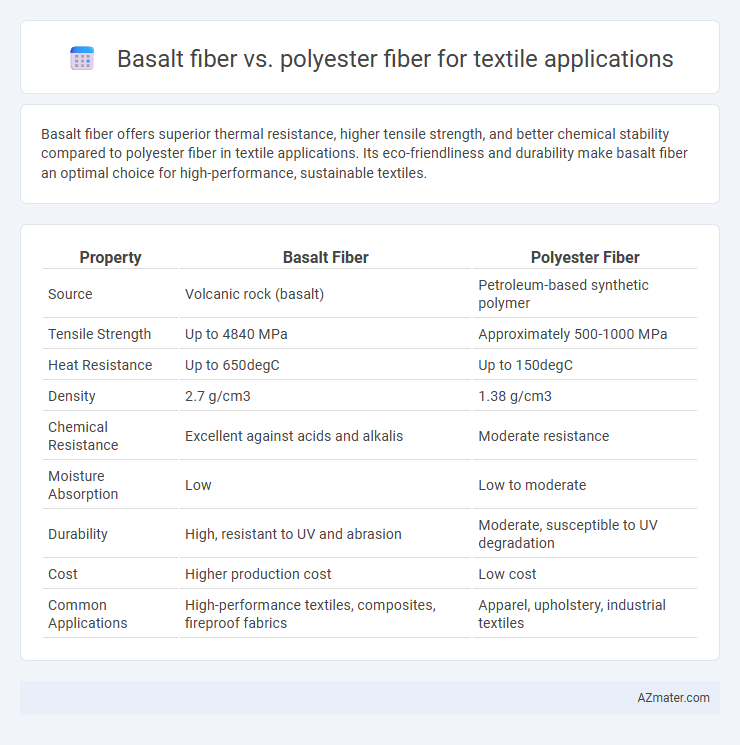Basalt fiber offers superior thermal resistance, higher tensile strength, and better chemical stability compared to polyester fiber in textile applications. Its eco-friendliness and durability make basalt fiber an optimal choice for high-performance, sustainable textiles.
Table of Comparison
| Property | Basalt Fiber | Polyester Fiber |
|---|---|---|
| Source | Volcanic rock (basalt) | Petroleum-based synthetic polymer |
| Tensile Strength | Up to 4840 MPa | Approximately 500-1000 MPa |
| Heat Resistance | Up to 650degC | Up to 150degC |
| Density | 2.7 g/cm3 | 1.38 g/cm3 |
| Chemical Resistance | Excellent against acids and alkalis | Moderate resistance |
| Moisture Absorption | Low | Low to moderate |
| Durability | High, resistant to UV and abrasion | Moderate, susceptible to UV degradation |
| Cost | Higher production cost | Low cost |
| Common Applications | High-performance textiles, composites, fireproof fabrics | Apparel, upholstery, industrial textiles |
Introduction to Basalt and Polyester Fibers
Basalt fiber, derived from natural volcanic basalt rock, offers superior thermal stability, high tensile strength, and excellent chemical resistance, making it an innovative option for advanced textile applications. Polyester fiber, a synthetic polymer fiber known for its durability, moisture resistance, and cost-effectiveness, remains widely used in textiles for apparel and industrial purposes. The distinct composition and performance attributes of basalt fiber versus polyester fiber influence their suitability in sectors requiring high-performance, eco-friendly, and durable textile solutions.
Raw Material Sources and Production Processes
Basalt fiber is derived from natural volcanic basalt rock, which is melted at high temperatures and extruded into fine filaments, offering sustainability through abundant and eco-friendly raw material sources. Polyester fiber originates from petrochemical products, typically polyethylene terephthalate (PET), produced via polymerization and filament spinning, relying on non-renewable fossil fuels. The production of basalt fiber involves energy-intensive melting but avoids chemical additives, whereas polyester fiber manufacturing involves complex chemical reactions and solvents, impacting environmental footprint differently.
Mechanical Properties Comparison
Basalt fiber exhibits superior mechanical properties compared to polyester fiber, featuring higher tensile strength typically ranging from 2,800 to 4,800 MPa versus polyester's 400 to 800 MPa, making it more suitable for high-performance textile applications. Basalt fibers also demonstrate enhanced abrasion resistance and better thermal stability up to 600degC, while polyester fibers degrade at temperatures above 150degC. The modulus of elasticity for basalt fiber is approximately 85-95 GPa, significantly surpassing polyester fiber's modulus of around 2-4 GPa, providing greater stiffness and durability in composite textiles.
Thermal Performance and Heat Resistance
Basalt fiber exhibits superior thermal performance and heat resistance compared to polyester fiber, withstanding continuous temperatures up to 650degC while polyester typically degrades around 150degC. The inherent mineral composition of basalt fibers provides enhanced flame retardancy and lower thermal conductivity, making them ideal for high-temperature textile applications. Polyester fibers, though flexible and cost-effective, lack the thermal stability necessary for environments demanding prolonged heat exposure.
Chemical Resistance and Durability
Basalt fiber exhibits superior chemical resistance compared to polyester fiber, maintaining stability in acidic, alkaline, and saltwater environments, making it ideal for harsh chemical exposures in textile applications. Basalt fiber's natural composition provides enhanced durability, retaining mechanical strength and resisting UV degradation better than polyester fibers, which tend to weaken and degrade with prolonged exposure to harsh conditions. For textiles requiring high longevity and resistance to corrosive substances, basalt fiber outperforms polyester fiber significantly.
Environmental Impact and Sustainability
Basalt fiber offers superior environmental benefits compared to polyester fiber due to its natural origin from volcanic rock, which requires minimal energy and no harmful chemicals during production. Unlike petroleum-based polyester, basalt fiber is fully recyclable and biodegradable, significantly reducing landfill waste and microplastic pollution in textile applications. The enhanced durability and thermal resistance of basalt fiber further extend product lifespan, promoting sustainable consumption and lowering the overall ecological footprint of the textile industry.
Cost Analysis and Market Availability
Basalt fiber offers superior mechanical properties and high thermal resistance compared to polyester fiber, but it generally incurs higher production and raw material costs, making it less cost-effective for large-scale textile applications. Polyester fiber benefits from well-established manufacturing infrastructure and widespread market availability, resulting in lower prices and easier procurement for textile manufacturers. Market trends show growing demand for basalt fiber in niche, high-performance textiles, though polyester dominates due to its affordability and extensive global supply chain.
Textile Processing and Compatibility
Basalt fiber offers superior thermal stability and chemical resistance compared to polyester fiber, making it more compatible with high-temperature textile processing techniques like heat setting and dyeing. Its natural mineral composition enhances durability and dimensional stability, while polyester fiber excels in moisture-wicking and flexibility during knitting and weaving processes. Both fibers exhibit compatibility with common textile finishing treatments, but basalt fiber requires adjusted processing parameters due to its higher melting point and rigidity.
Typical Applications in the Textile Industry
Basalt fiber is increasingly utilized in technical textiles for its superior thermal resistance, chemical stability, and mechanical strength, making it ideal for fireproof clothing, automotive textiles, and geotextiles. Polyester fiber remains dominant in fashion and home textiles due to its flexibility, cost-effectiveness, moisture-wicking properties, and ease of dyeing. The choice between basalt and polyester fibers hinges on application requirements such as durability, environmental resistance, and comfort in end-use products within the textile industry.
Future Trends and Innovations in Fiber Technology
Basalt fiber is emerging as a sustainable alternative to polyester fiber in textile applications due to its superior thermal stability, chemical resistance, and environmental benefits, aligning with the growing demand for eco-friendly materials. Innovations in fiber technology focus on enhancing the mechanical properties of basalt fiber through nanotechnology and hybrid composites, improving its flexibility and cost-effectiveness for wider textile adoption. Future trends include integrating smart textile features with basalt fibers for high-performance uses in automotive, aerospace, and protective clothing industries, driving research towards multifunctional and durable fiber solutions.

Infographic: Basalt fiber vs Polyester fiber for Textile application
 azmater.com
azmater.com